Any links to online stores should be assumed to be affiliates. The company or PR agency provides all or most review samples. They have no control over my content, and I provide my honest opinion.
I reviewed the Chargeasap Omega 200W GaN charger three years ago and loved it. It was one of the first high-powered PD3.0 multi-port GaN chargers I had reviewed. The only issue I had with it was my review sample was a US two-pin charger, but I still use it now whenever I have trips to the US, and it has been an excellent travel charger.
Since then, I have reviewed plenty of other PD3.0 chargers, including the Ugreen Nexode 140W GaNFast Charger and Anker 737 GaNPrime Charger.
Recently, Chargeasap launched their latest flagship charger, and it puts everything else I have tested to shame.
This charger is capable of 270W output in total, significantly higher than the options from Ugreen and Anker. It can do up to 140W from one of the USB-C ports, then has another two which are rated up to 100W. The USB-A port is rated up to an unusually high 36W using QC3.0, and they also support SCP, VOOC(22.5W) for faster charging with proprietary standards.
It then has an OLED display which shows you the voltage, amp and watts being used per port.
Finally, this is shipped with 4 x travel adapters (US, EU, UK, AU).
The downside to such a feature-rich and powerful charger is the price. This is $219, making it the most expensive charger I have reviewed by far.
Features
- World First: With its Gallium Nitride (GaN) technology, it’s 66% smaller than traditional chargers but packs a powerful punch of 270W of charging power
- 4 x Navitas NV6127 power ICs, our charger boasts superior heat dissipation and high efficiency in a compact, cost-optimised design
- Advanced components like GaN IC, graphene membrane, thicker copper, and graphene aerogel insulation film ensure external temperature remains below 75ºC
- GaN charger with 0 recalibration time between C1 & C2, and 0.5 sec between C3 & A1. A significant improvement over current GaN chargers
- Charge 4 Devices Simultaneously: Quickly charge your 16″ MacBook Pro laptop, iPad Pro tablet, iPhone smartphone, and AirPods and Watch mobile devices simultaneously. Optimised for fast charging and convenience
- iPhone 14 20W Fast Charge Compatible: Advanced IC software guarantees compatibility with iPhone 14’s 20W fast charge speeds
- Accurate Power Distribution: Get lightning-fast laptop charging with Zeus. Its laptop-first power distribution prioritises the C1 port at 140W, guaranteeing your laptop is charged at maximum speed.
- Worldwide Compatibility: Universal Voltage 100V-240V with 4 included travel adapters (US/AU/EU/UK) for use in over 200 countries worldwide.
Specification
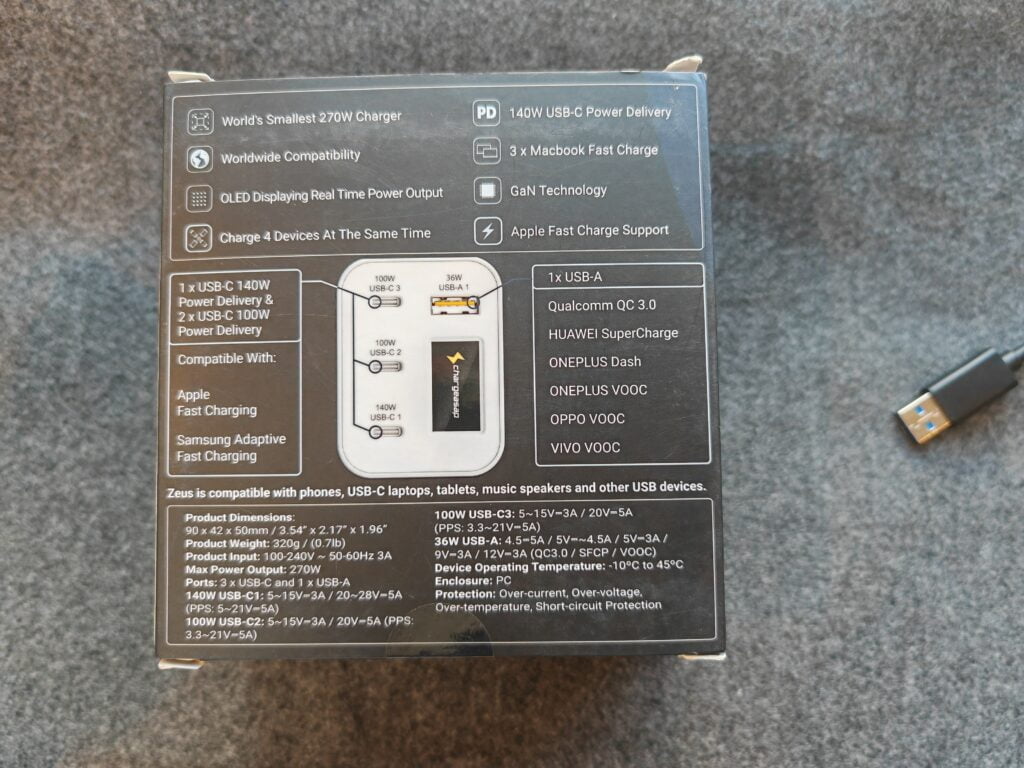
- Product Dimensions: 90 x 42 x 50mm/3.54” x 2.17” x 1.96”
- Product Weight: 320g / (0.7lb)
- Power Input: 100-240V ~ 50-60Hz 3A
- Max Power Output: 270W
- Ports: 3 x USB-C and 1 x USB-A
- 140W USB-C1: 5~15V⎓3A / 20~28V⎓5A (PPS: 5~21V⎓5A) (PPS/PD3.1/PD3.0/PD2.0/QC4/QC3.0/QC2.0/AFC/FCP/SCP/PE2.0/PE1.1/SFCP)
- 100W USB-C2: 5~15V⎓3A / 20V⎓5A (PPS: 3.3~21V⎓5A)
- 100W USB-C3: 5~15V⎓3A / 20V⎓5A (PPS: 3.3~21V⎓5A)
- 36W USB-A1:4.5⎓5A / 5V⎓~4.5A / 5V⎓3A / 9V⎓3A / 12V⎓3A (QC3.0) SCP, VOOC (22.5W)
- Device Operating Temperature: -10ºC to 75ºC
- Enclosure: PC
- Protection: Over-current, Over-voltage, Over-temperature, Short-circuit Protection
The packaging also confirms that the USB-A port supports:
Huawei SuperCharge, OnePlus Dash, OPPO/OnePlus/Vico VOOC
Port Power Configuration
- C1 = 140W
- C2 or C3 = 100W
- A1 = 36W
- C1 + C2 or C3 = 140W + 100W
- C1 + C2 + C3 = 140W + 65W + 65W
- C1 + A1 = 140W + 36W
- C1 + C2 or C3 + A1 = 140W + 65W + 36W
- 4 ports used simultaneously: 140W + 65W + 12W + 12W
- Our 270W Zeus has a laptop-first power distribution which means the C1 port will also be prioritised at 140W to ensure your laptop will always charge as fast as possible and not be interrupted by devices being plugged or unplugged
Design
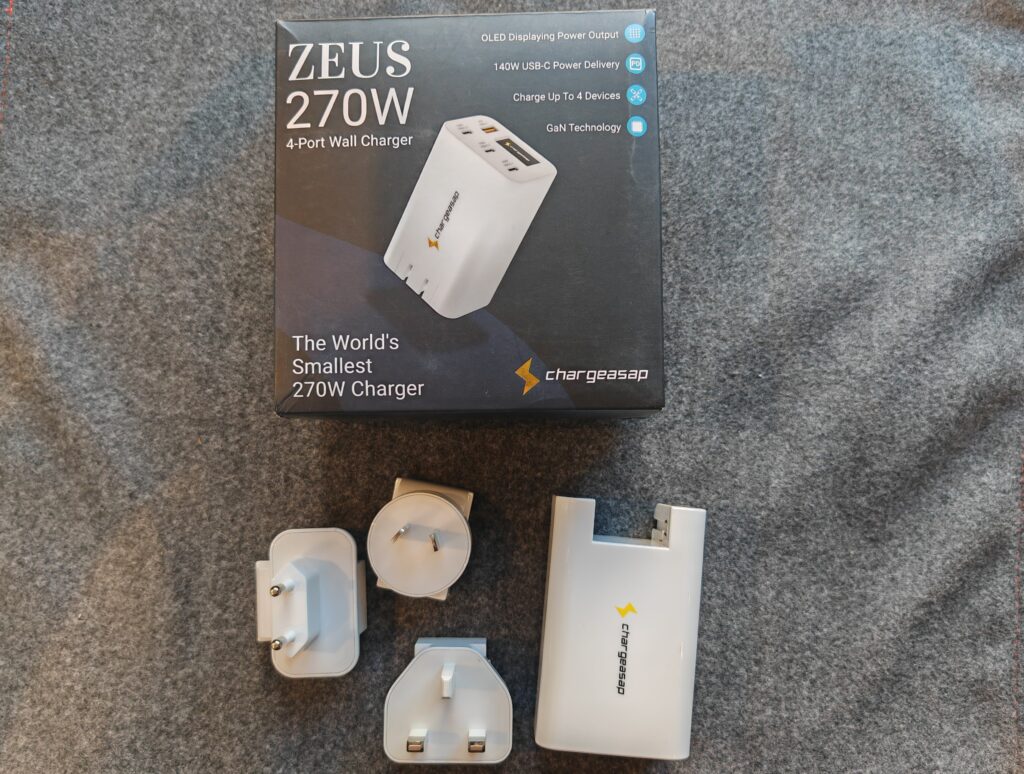
Similar to the Chargeasap Omega, this has a tall and thin design which is a bit top-heavy, but it reduces how much space it takes up on power trips or double sockets and, therefore, shouldn’t block any other socket.
Impressively, it is not that much bigger than the Omega, and it only weighs 5g more.
The design has been updated with a slotted adaptor allowing this to be converted to either US, UK, EU or Aus and it is supplied with all four adaptors, making this a perfect travel charger. The Omega was sold with adaptors, but the two-prong US ports are fixed in place, so I assume this then plugs into an adopter.
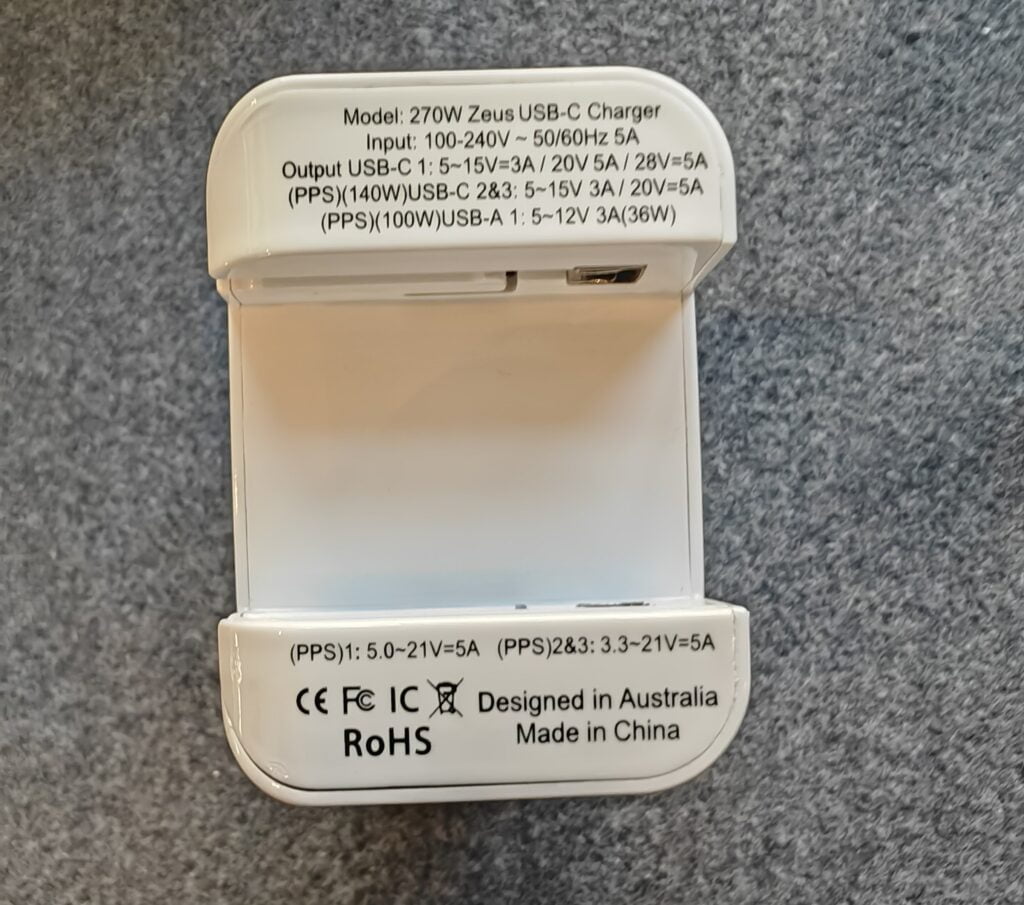
The adaptors slot in and require quite a bit of force to remove. There is then two metal contact points that they clip into.
My main criticism of this charger is that it is quite tall, thin and heavy at 320g. I have not tested it, but I imagine this may have a similar issue to the Chargeasap Omega, where the high centre of gravity makes the less secure two-pin plugs feel a bit unstable. For the UK three-pin plugs, it locks into the socket securely, so there is no concern there.
Then on the top of the charger, you have the three USB-C ports, a USB-A port and the OLED screen.
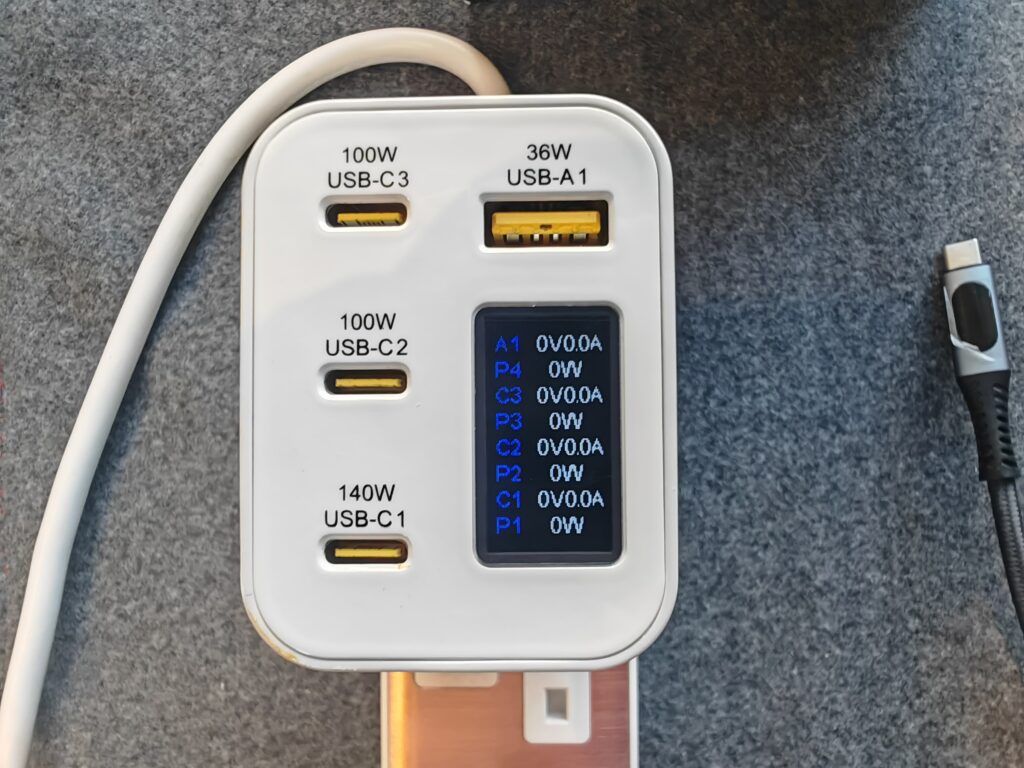
I am a big fan of the various plugs, cables and power banks that include a display showing the power output. It may not be incredibly useful for normal people, but it is great for me when reviewing things to see how much power something is using. It is also handy for regular use so you have an idea of how quickly something is charging.
Performance
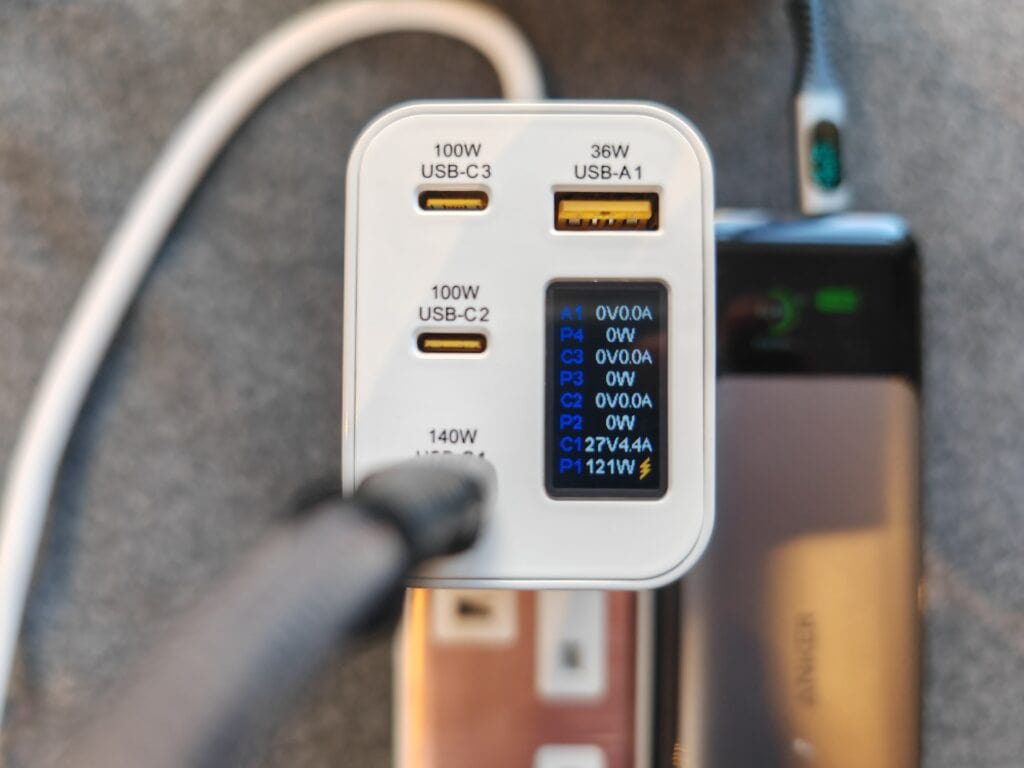
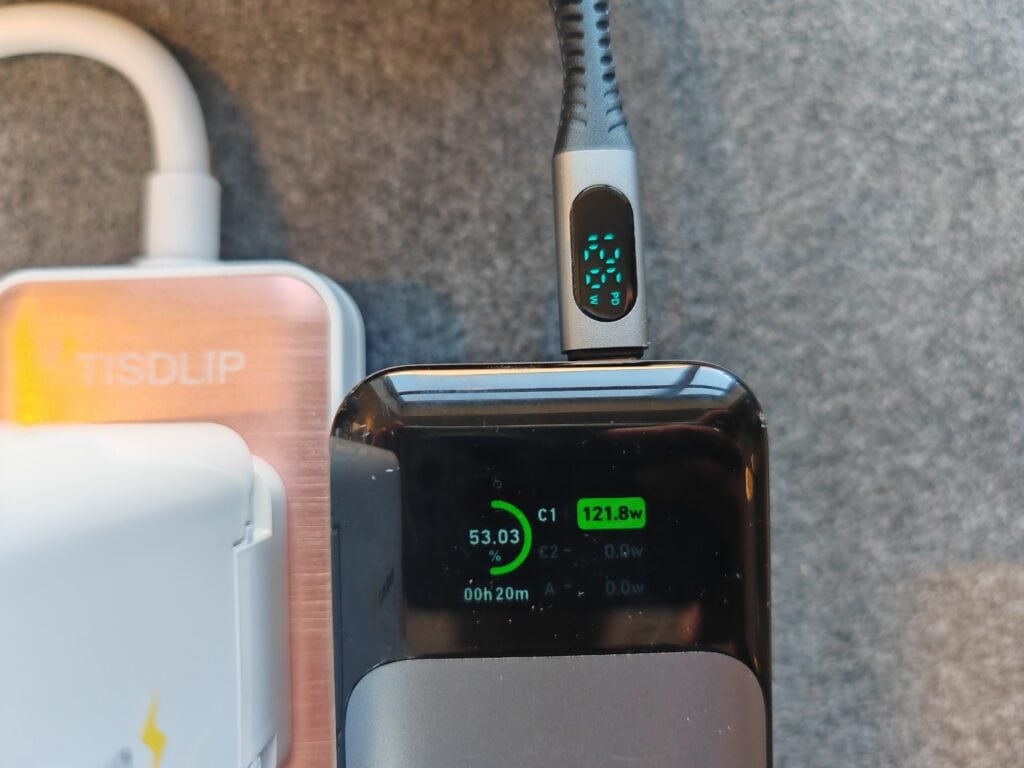
I didn’t quite manage to get 270 watts out of this. Looking at the power distribution specs, you would need to use the three USB-C ports at 140W + 65W + 65W, and I didn’t have enough high-powered devices on hand to achieve this.
With all four ports in use, your best output is 140W + 65W + 12W + 12W, which works out at 229W.
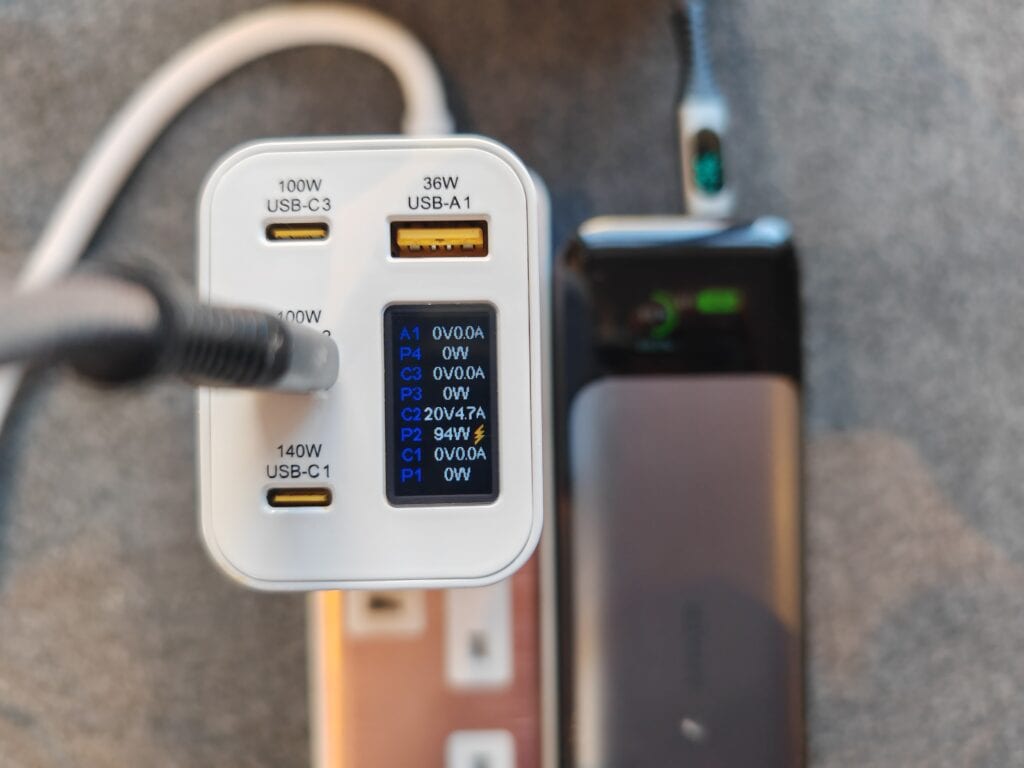

The Anker 737 Power Bank can accept a charge up to 140W, but I find the best I achieve when it is already holding some charge is 125W, the ZHIYUN MOLUS X100 will also draw 100W at full power.
I used the Anker to test each port individually and checked the OLED display against the display on the power bank and also the display on the USB4 cable I was using. The 140W port capped out at 125W, which matches the performance from Ugreen Nexode 140W. My best guess is that the Anker only takes 140W when completely drained.
Then the 100W ports were fully utilised when I tested these.
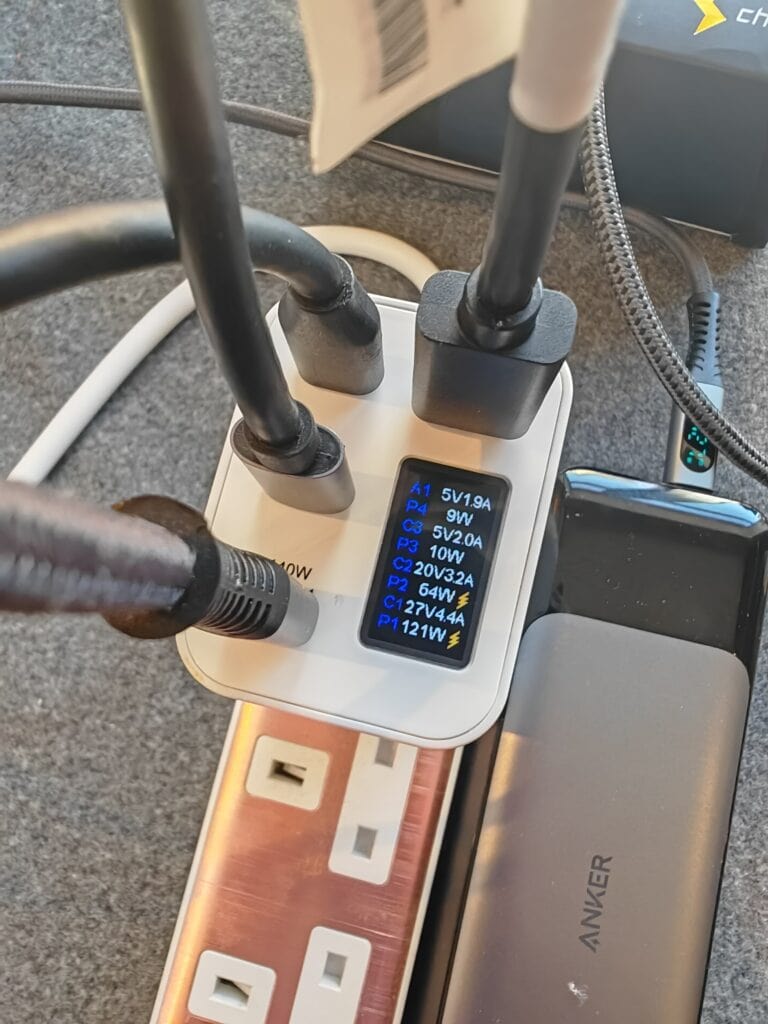
With four devices plugged in, I was able to get 125W + 65W + 10W + 10W for a total output of 210W. A touch below what it is capable of, but I think this was a limitation of my devices, not the charger.
Price and Alternative Options
The Chargeasap Zeus 270W GaN Charger is available to buy now directly from Chargeasap for $219.
There is free shipping worldwide on orders more than $99. However, the customer will be responsible for paying all import duties and taxes.
For UK buyers, that means the charger is about £172, and if you get stung with duty and VAT, my best guess is this will cost you:
- Duty: 5.66 GBP (Rate of 3.3 %)
- VAT: 35.45 GBP (Rate of 20 %)
- Total: 41.11 GBP
Taking the total to £213.
The Omega 200W is still available to buy, and this is $149. My review sample didn’t come with adaptors, but when you buy it at retail, you get adaptors that convert it from US to AU/EU/UK.
While that does sound insanely expensive, there is nothing that really competes with it, and you can pay around £100 for something much less powerful or versatile.
The Anker 737 Charger (GaNPrime 120W), which only has 2 USB-C ports,120W total output, no display and uses a fixed UK socket, is £84.99.
The Ugreen Nexode 140W has 140W total output with 140W per a single USB-C port, no display and a fixed socket. This is £77.
The SATECHI 165W USB-C 4-Port PD GaN Charger is more of a desktop charger with four USB-C ports and a max of 100W for one of the USB-C ports. This is £110.
The Targus HyperJuice 245W GaN Desktop Charger has four USB-C ports with up to 100W per port and is obviously a desktop design. This is £150.
Anker has the 749 Prime 240W charger, which is designed for desktops and is due to launch soon.
Overall
The Chargeasap Zeus 270W GaN charger is the best-specced charger that you can buy today (that I am aware of).
If anything, the 270W is over the top for my needs, but it gives me the flexibility to charge multiple devices at one time at the fastest speeds possible. The most demanding scenario I can imagine is when travelling, I can charge my Anker 737 power bank at its full input rate while powering my laptop and charging my phone all at the same time. No other charger on the market can do that at the moment.
Chargeasap makes this even more appealing thanks to the travel adaptors, which is a huge selling point for me, and you get the OLED display to sweeten the deal.
For UK buyers, you would potentially be spending over £200 on this, which is tough to swallow, but looking at the competing options, this has the power and flexibility of multiple plugs, which can help justify the high price.
Chargeasap Zeus 270W GaN Charger Review Rating
Summary
The Chargeasap Zeus 270W GaN charger is the best-specced charger that you can buy today and includes incredibly useful travel adaopters and a handy OLED display.
Overall
95%-
Overall - 95%95%
Pros
- 270W total output with 140W + 65W + 65W
- US, EU, UK, AU adaptors
- Handy OLED display to show the power usage
Cons
- High Price
- Not sold in the UK, VAT and Duty fees will likely apply
I am James, a UK-based tech enthusiast and the Editor and Owner of Mighty Gadget, which I’ve proudly run since 2007. Passionate about all things technology, my expertise spans from computers and networking to mobile, wearables, and smart home devices.
As a fitness fanatic who loves running and cycling, I also have a keen interest in fitness-related technology, and I take every opportunity to cover this niche on my blog. My diverse interests allow me to bring a unique perspective to tech blogging, merging lifestyle, fitness, and the latest tech trends.
In my academic pursuits, I earned a BSc in Information Systems Design from UCLAN, before advancing my learning with a Master’s Degree in Computing. This advanced study also included Cisco CCNA accreditation, further demonstrating my commitment to understanding and staying ahead of the technology curve.
I’m proud to share that Vuelio has consistently ranked Mighty Gadget as one of the top technology blogs in the UK. With my dedication to technology and drive to share my insights, I aim to continue providing my readers with engaging and informative content.

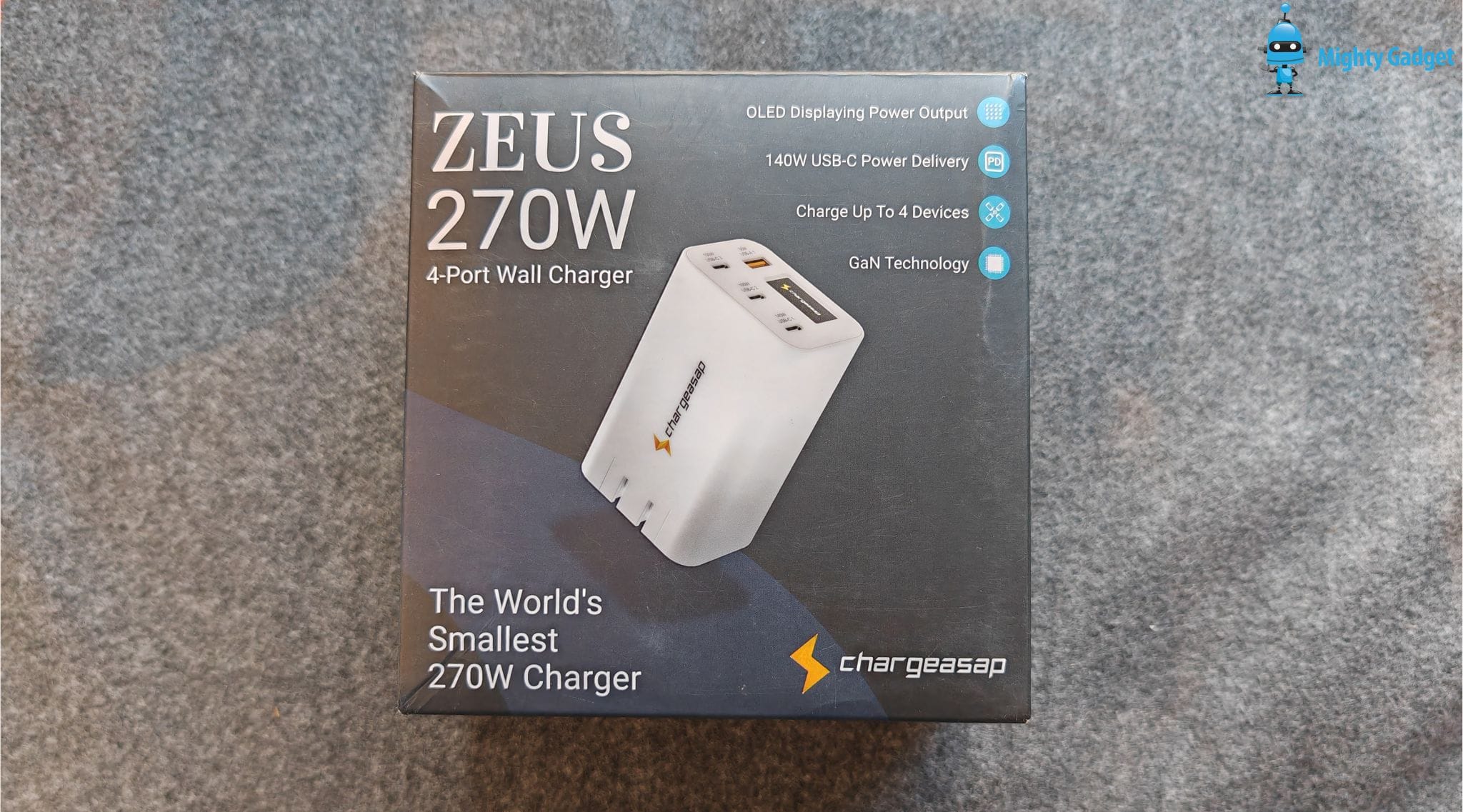

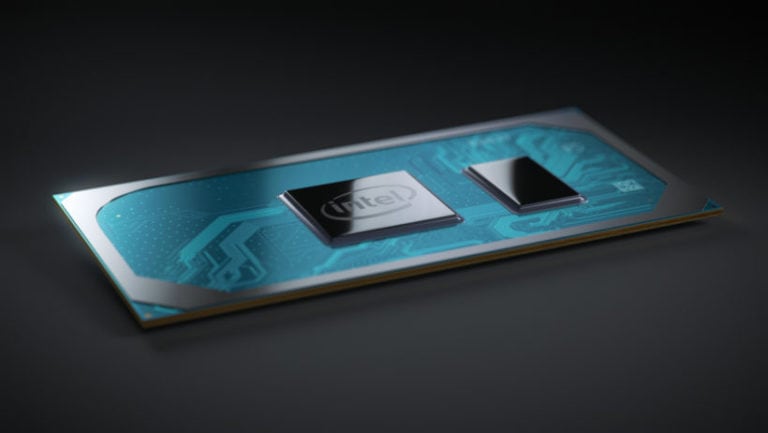


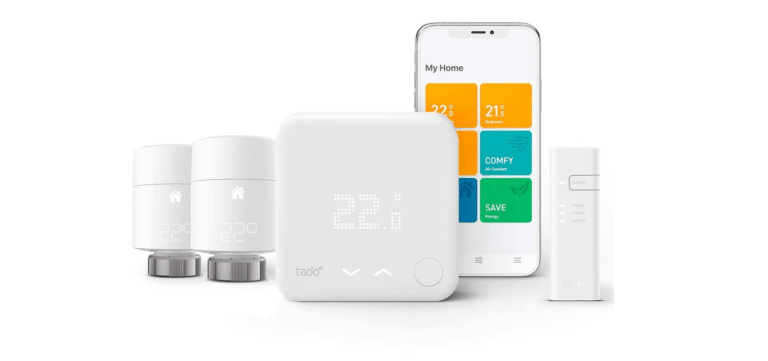
Regarding chargeasap’s Zeus 270w charger, you can call it the more powerful brother of the omega 200w charger in which is a great charger itself which has performed great for me in the 2 months I’ve owned it. Anyways, back to the Zeus charger, it looks virtually identical and is hardly any bigger or heavier than my omega charger and in addition has a OLED display which my omega lacks. So to sum it up, the Zeus is everything the omega is and more, and more is always better.